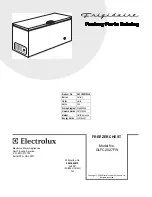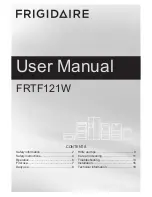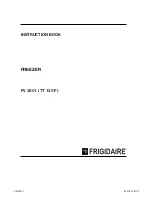
5-13
Sealed System
Robinair has stated that their current and discontinued
vacuum pump models, using mineral oil currently
specified for use in their vacuum pumps, can be used to
evacuate R-134a/Ester oil systems. Robinair also states
that it is acceptable to alternate between evacuating
R-12/mineral oil and R-134a/Ester oil systems without
adversely effecting the vacuum pump’s performance.
For other brands of vacuum pumps, check with the
manufacturer for restrictions and guidelines when using
with R-134a.
Check the serial plate for the correct refrigerant
type. It is extremely important to verify the type of
refrigerant in the system before starting any sealed
system repairs.
With the possible exception of the vacuum pump,
all service equipment that comes in contact with
R-134a during evacuation and recharging must
be dedicated. Accordingly, R-134a will require a
dedicated charging cylinder, manifold gauge set,
process tube adapters, and hoses. Any residual
mineral oil on other tools (tubing cutter, etc.) must
be thoroughly cleaned off before using on R-134a/
Ester oil systems. It will be necessary to check
with the manufacturer of your vacuum pump for
refrigerant and oil compatibility issues.
If you use a vacuum pump with mineral oil to
evacuate an R-134a system, it is ABSOLUTELY
ESSENTIAL to have a shut-off valve between the
pump and your manifold gauge set as shown on
page 4-10. The hand valve must be closed during
all times when the vacuum pump is not operating.
This will prevent the migration of mineral oil vapor
into the R134a/Ester oil system. If the vacuum
pump should stop during evacuation for any
reason, the hand pump shut-off valve must be
closed immediately.
Insure that your refrigeration hoses are specified
for use with R-134a refrigerant. Research has
shown that compounds in standard refrigeration
hoses may enter sealed systems and ultimately
restrict the cap tube in an R-134a system.
Dedicated Equipment
R-134a must not be mixed with other types of
refrigerants. R-134a must be recovered in dedicated
and properly identified recovery bags and tanks.
It will be necessary to check with the manufacturer of
your recovery equipment to determine R-134a
compatibility. Some recovery equipment manufactur-
ers have changeover instructions for switching between
refrigerant types. Protect yourself and your equipment
by following all manufacturer guidelines.
Also, ensure that your refrigeration hoses are specified
for use with R-134a refrigerant. Research has shown
that compounds in standard refrigeration hoses may
enter sealed systems and ultimately restrict the cap
tube in an R-134a system.
For example, hoses that were used for a refrigeration
system operating on R-12 may contain small quantities
of mineral oil which can block the capillary tube in a
system operating on R-134a. As little as one milligram
may be sufficient to cause a blockage. In addition,
sealed system components that have been used with
CFC systems must not be used with R-134a systems.
These components may contain residual amounts of
refrigerant and oil which could damage an R-134a
system.
At the earliest stage of development work on R-134a,
tests were carried out on a different type of synthetic oil
known as Poly-Alkaline Glycol (PAG). This oil is also
used in certain air conditioning systems for cars. PAG
and Ester oil DO NOT mix with one another. Service
equipment used for R-134a / Ester oil must not come
into contact with PAG.
Vacuum Pump Maintenance
It is absolutely essential to maintain your vacuum pump
according to the manufacturer’s instructions, includ-
ing required oil changes at the recommended intervals.
Vacuum pump oil should always be changed after
evacuating a contaminated system. Vacuum pump
performance should be checked periodically with a
micron gauge.
Vacuum pump suppliers may or may not recommend
changing the vacuum pump oil to the same type that’s in
the system being evacuated. Some manufacturers may
recommend a vacuum pump that’s dedicated to
R-134a systems.
Содержание E32AR75FPS
Страница 2: ......
Страница 8: ...Basic Information 1 6 Model Number Breakdown Serial Number Breakdown All Refrigerator Specifications ...
Страница 10: ...1 8 Basic Information All Freezer Specifications ...
Страница 12: ...1 10 Basic Information Notes ...
Страница 24: ...Installation Information 2 12 Figure 2 21 Figure 2 22 ...
Страница 25: ...Installation Information 2 13 Figure 2 23 Figure 2 24 ...
Страница 28: ...Installation Information 2 16 Notes ...
Страница 43: ...Ice Maker 4 13 ...
Страница 44: ...Ice Maker 4 14 ...
Страница 62: ...Sealed System 5 18 HFC 134a CFC 12 Pressure Temperature Chart ...
Страница 90: ...Component Teardown 6 26 Notes ...
Страница 92: ...Parts List 7 2 All Freezer Pro Cabinet Exploded View Model E32AF75FPS ...
Страница 94: ...Parts List 7 4 All Freezer Pro System Exploded View Model E32AF75FPS ...
Страница 96: ...Parts List 7 6 Ice Maker Exploded View Model E32AF75FPS ...
Страница 98: ...Parts List 7 8 All Refrigerator Pro Door Exploded View Model E32AR75FPS ...
Страница 100: ...Parts List 7 10 All Refrigerator Pro Cabinet Exploded View Model E32AR75FPS ...
Страница 102: ...Parts List 7 12 All Refrigerator Pro System Exploded View Model E32AR75FPS ...
Страница 104: ...Parts List 7 14 Notes ...
Страница 108: ...Troubleshooting 8 4 Notes ...
Страница 109: ...9 1 Wiring Schematics Ice Maker Schematic ...
Страница 110: ...Wiring Schematics 9 2 All Freezer Pro Wiring Diagram ...
Страница 111: ...Wiring Schematics 9 3 All Refrigerator Pro Wiring Diagram ...
Страница 112: ...Wiring Schematics 9 4 Notes ...
















































